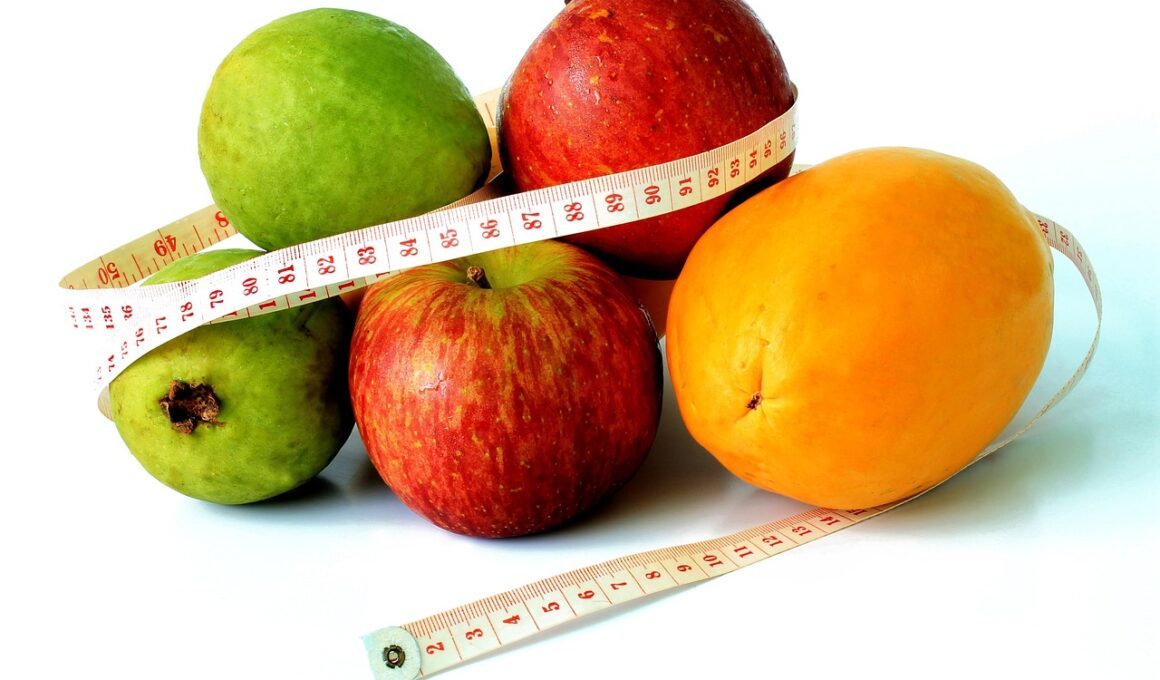How to Interpret Calorie Tracking Data Post-Exercise
Tracking calories after a workout is crucial for understanding your post-workout nutrition. It allows you to assess whether you are fueling your body effectively. A good initial step is to choose a reputable app or tool to monitor your caloric intake, which can be beneficial when managing energy balance. When evaluating your data, consider your workout’s intensity. High-intensity workouts often require more recovery calories due to increased energy expenditure. Look for patterns in your calorie consumption on days when you have exercised versus those when you haven’t. Maintaining a consistent approach helps ensure your data reflects your actual nutritional needs. Likewise, take note of how certain foods impact your performance. Specifically, monitor how your body reacts to different macronutrient ratios. For instance, some individuals perform better when they emphasize carbohydrates post-workout. Don’t forget about hydration, as it plays a vital role in recovery. Tracking your fluid intake alongside calories is equally important for overall post-exercise recovery. In conclusion, interpreting these data effectively will enhance your nutrition regimen and improve recovery outcomes. It’s about optimizing your overall health and fitness goals for long-lasting effects.
Understanding Macronutrient Ratios
When analyzing your post-workout nutrition data, pay special attention to your macronutrient ratios. These ratios can significantly influence your body’s recovery and performance levels. A common guideline suggests that after exercise, one should consume a mix of carbohydrates and protein. For example, consuming approximately 3:1 ratio of carbs to protein can help replenish glycogen stores while supporting muscle repair. Additionally, consider fats in your overall diet, as they play a crucial role in hormone regulation. However, prioritize carbohydrates and proteins within one to two hours after your workout for optimal recovery support. As you track your caloric intake, note how these macronutrient ratios impact your energy levels and muscle soreness in subsequent workouts. Pay attention to individual differences, as each person may respond differently based on genetics, fitness level, and workout intensity. Furthermore, utilize apps that detail the macronutrient content of foods to support your tracking efforts. This will help you ensure you stick to your targeted ratios reliably. Over time, you’ll discover which foods best support your personal recovery and performance goals, leading to long-term improvements in your overall fitness journey.
Alongside macronutrients, timing is essential when it comes to post-workout nutrition. Consuming nutrients within a certain window post-exercise can optimize recovery. Research suggests that a window of 30 to 60 minutes is ideal for nutrient absorption. This timing allows your muscles to absorb nutrients effectively, aiding in recovery and rebuilding processes. Many recommend preparing a post-workout snack or meal ahead of time to ensure accessibility. Having readily available options can eliminate excuses for missing this critical nutrition window. In addition, be sure to track meal timings in your app alongside calories consumed. Post-exercise meals should also prioritize hydration. Water plays a crucial role in various bodily functions, including nutrient transport and recovery. Ensure that you also replenish any lost electrolytes, particularly after intense workouts. Incorporate hydrating foods or drinks if necessary. Pay attention to how different hydration levels influence your performance in subsequent training sessions. Over time, you may notice that your recovery and overall performance improve as you remain diligent with both your calorie tracking and meal timing practices. Ultimately, staying consistent with these approaches will benefit your long-term health.
Another vital aspect of tracking calories post-workout is to maintain awareness of your overall daily intake. Often, individuals might focus solely on post-exercise calories while neglecting daily nutrition. Balance is key for sustained energy levels and effective recovery. Review your entire day’s caloric intake and assess how it aligns with your individual energy expenditure. Understand that excessive calorie deficits can hinder recovery, which may lead to fatigue and underperformance. Analyzing this data allows for smarter meal planning. You can avoid drastic swings in energy levels during your workout routine. In addition, regularly tracking your intake can illuminate any potential deficiencies or excesses in your diet. For example, you might identify patterns where you consistently fall short in certain vitamins or minerals. To improve your sustenance, aim for a diet rich in whole foods full of diverse nutrients. By doing this, you optimize your post-exercise nourishment and recovery while promoting overall health. Ongoing awareness of daily intake patterns will help you achieve your fitness goals faster, fostering a healthier relationship with food and exercise.
Utilizing Data to Enhance Future Workouts
Interpreting calorie tracking data post-exercise also involves looking forward. As you gather data, use it to inform future workouts and recovery practices. For example, consider how different meal timings and food choices impact your energy levels during subsequent exercises. If you find that certain foods enhance performance, try to incorporate them more regularly into your meals. On the other hand, if you notice sluggishness after particular meals, reconsider those choices in the future. Tracking your data over time can help identify repeatable trends and responses, ultimately optimizing your training. Additionally, monitor your overall mood and energy following workouts. Sometimes, calorie intake might seem sufficient, but the body may react negatively to certain foods, affecting performance. Adjusting your post-workout meals according to this data can help you achieve better results in both training and recovery periods. It’s crucial to keep an open mind, experimenting with various food combinations until you discover what works most effectively for you. Ideally, the data should guide you in making informed dietary decisions for improvements. Over time, this will lead to better workout experiences and clearer exercise goals for your future.
Finally, consider incorporating a social aspect into your calorie-tracking journey. Sharing your progress with a supportive community can motivate you to stay consistent and accountable. Encourage friends or family to join you in tracking their post-workout nutrition and workout efforts, enhancing camaraderie. You can exchange tips and strategies for improving nutrient intake as well as share experiences about what nourishes your body best after exercising. There are various platforms, such as social media or messaging apps that can facilitate this shared experience. Participating in community challenges related to nutrition or fitness can boost your motivation and promote adherence. Furthermore, accountability often leads to more significant improvements overall. If you know others are keeping track of their goals, you might be more inclined to stick with your own. Set realistic expectations when embarking on this shared journey and celebrate milestones achieved together. Don’t underestimate the power of community support when it comes to health and fitness. Staying driven with the right motivation can help you maximize the benefits of your calorie-tracking approach post-workout.
In conclusion, effectively interpreting and utilizing calorie tracking data post-exercise can enhance fitness outcomes remarkably. By focusing on macronutrient ratios, recovery timing, and hydration, you create a solid nutrition foundation. Continually analyze daily nutritional habits while adapting based on outcomes. This holistic approach empowers you to leverage data for more informed decisions. Remember, it’s not just about counting calories but fostering a positive relationship with food. Engaging with a community can amplify motivation and promote accountability, making the journey more enjoyable and sustainable. Set goals, stay consistent, and track progress through good and bad days to achieve lasting results. Try to introduce variety into your diet and embrace new challenges that enhance nutrient exploration. As you seek to optimize your post-workout nutrition, remain open-minded about experimenting with practices until you find what works best for you. Over time, this adaptability can lead to improved recovery times and workout experiences. Ultimately, the goal is to empower yourself with knowledge and utilize the data collected to support your journey towards better health and fitness. Embrace each step forward, and enjoy the transformations it could bring.
In conclusion, effectively interpreting and utilizing calorie tracking data post-exercise can enhance fitness outcomes remarkably. By focusing on macronutrient ratios, recovery timing, and hydration, you create a solid nutrition foundation. Continually analyze daily nutritional habits while adapting based on outcomes. This holistic approach empowers you to leverage data for more informed decisions. Remember, it’s not just about counting calories but fostering a positive relationship with food. Engaging with a community can amplify motivation and promote accountability, making the journey more enjoyable and sustainable. Set goals, stay consistent, and track progress through good and bad days to achieve lasting results. Try to introduce variety into your diet and embrace new challenges that enhance nutrient exploration. As you seek to optimize your post-workout nutrition, remain open-minded about experimenting with practices until you find what works best for you. Over time, this adaptability can lead to improved recovery times and workout experiences. Ultimately, the goal is to empower yourself with knowledge and utilize the data collected to support your journey towards better health and fitness. Embrace each step forward, and enjoy the transformations it could bring.


